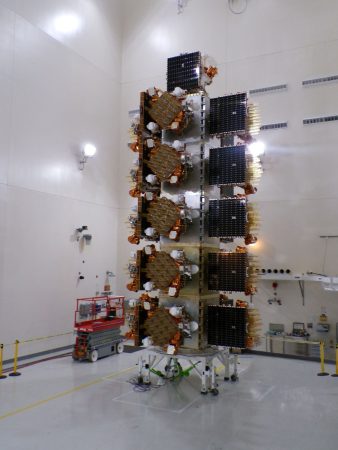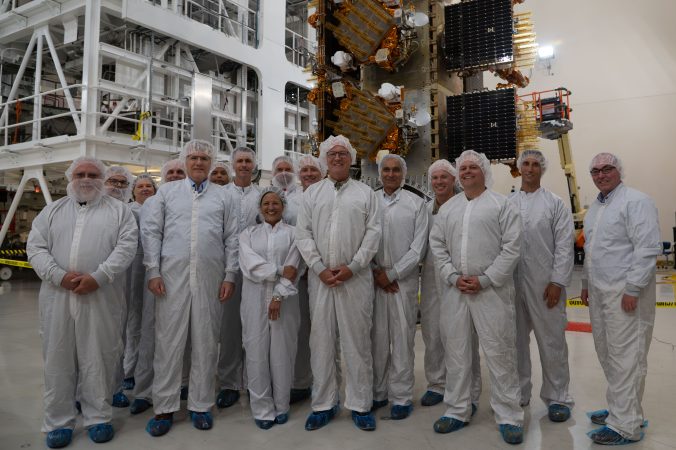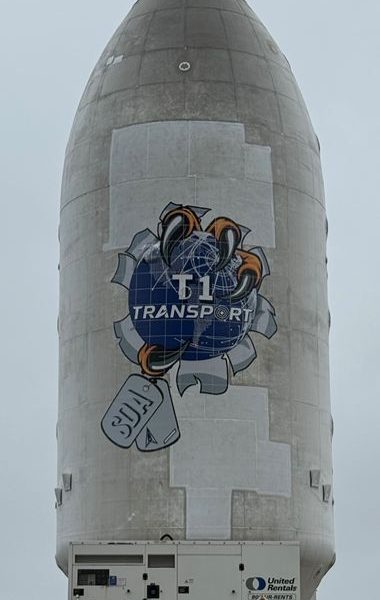The Space Development Agency is ready to start launching operational satellites—and launch and launch again over the next 10 months.
Twenty-one of SDA’s low-Earth orbit satellites are scheduled to launch shortly after 7 a.m. Pacific time on Sept. 10. The spacecraft, built by York Space Systems, will fly atop a SpaceX Falcon 9 rocket from Vandenberg Space Force Base, Calif.
“This is a great day for SDA and also for the warfighter, more importantly, because the mission that we’ve been on for the last six and a half years is to deliver capability to a warfighter,” SDA’s acting director Gurpartap “GP” Sandhoo told reporters in advance of the launch.

SDA launched 27 demonstration “Tranche 0” satellites in 2023 and 2024, but this launch will kickstart Tranche 1, which is much bigger and meant to be used for operations. All told, the batch has 126 data transport satellites, including the 21 launching Sept. 10, and 28 missile warning birds.
Assuming the Sept. 10 launch goes smoothly, Sandhoo confirmed that SDA is targeting its next launch in the second week of October, part of a regular monthly cadence. Tranche 1 is meant to include six launches of data transport satellites, and four for missile warning satellites. All of the launches at this point are planned from Vandenberg.
The first launch will be streamed live by SpaceX but the stream will not actually show the satellites being deployed, SDA officials said.
“It has taken the combined effort of both the government and contracting team to get to where we’re at and to be able to launch these satellites on [Sept. 10],” said Chief Program Officer Mike Eppolito. “There is a ton of effort that goes into building the satellites, developing the software, and standing up all the ops facilities that are required to be ready.”
Once the satellites are in orbit, a whole new kind of work begins.
“We’ll be checking on the health and safety of the busses,” Eppolito said. “And we’ll focus on bus checkout, make sure the payloads are safe, and then the payload checkout always happens after bus checkout.”
“Then we’ll start working down the path, if you look at the SDA architecture, we are launching each plane, and then you start connecting things within the planes and down to the ground,” said Sandhoo. “So those are the initial sets of stuff that we’ll do. Once that is all validated and worked out, then we’ll start going down the path of test.”
Testing will include working with so-called “early adopters” who will try out the new satellites and start integrating them into their exercises. Those early adopters include forces in Asia and the Pacific, Sandhoo said, to include the Space Forces Indo-Pacific component.
It will take “at least a few months” for the satellites to complete test and checkout and start providing operational value, Sandhoo added. With each subsequent launch of Tranche 1 satellites, SDA will be able to provide more and more coverage.
The data transport satellites being launched first are a key part of what the Pentagon hopes to achieve with Joint All-Domain Command and Control. Essentially, Sandhoo said, the satellites will enable tactical communications “beyond the line of sight”—connecting forces in the field with sensors and battle managers thousands of miles away.
“Now you’re able to talk, not only to within a couple hundred miles from where your Link 16 radios, we can use a space to, let’s say, go from Hawaii out to Guam, using those tactical radios and using a space layer … as a relay,” he said.
In early 2026, SDA plans to launch its first Tranche 1 missile tracking satellites, which will be key to the Pentagon’s broader “Golden Dome” initiative for tracking and defending against all kinds of missile threats.
Beyond that, the first Tranche 2 satellites are meant to start launching in fall 2026 and continue into 2027. SDA does face pressure to make those ambitious timelines after supply chain delays pushed back the Tranche 1 launches.
“I think we always understood we would have some growing pains here as we got the supply chain up and operating,” Eppolito said. “Those supply chain issues tend to cascade into your integrated tests later in life. But … we are seeing improvements on T2. We would expect to improve the supply chain as we move forward here. So we’re sort of excited about where we will be in the future here in terms of buying down those timelines.”
The speed and cadence of launches SDA is planning is unlike anything the Pentagon has ever attempted before, as military space programs sometimes go years between satellite launches.
Yet the agency also faces headwinds. Its first permanent director, Derek M. Tournear, departed Sept. 8 for a job in academia, and Sandhoo confirmed that plans for Tranche 3 data transport satellites remain on hold as the Defense Department reviews potential commercial options.
The watchdog Government Accountability Office has also raised concerns about the laser communications technology that underpins the satellite architecture, but Sandhoo and Eppolito argued that the agency has made considerable progress proving it out since GAO raised its objections and they are confident it will work for Tranche 1.
Still, it remains to be seen if operators in the field will widely adopt SDA’s capabilities.



